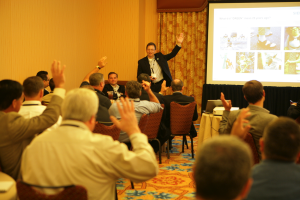Design Considerations
When planning a meeting, there are many design techniques that should be taken into consideration to amplify the delivery of your message and to fully engage your audience. By using these particular practices, your meeting will be more productive and worthwhile:

1. “What’s In It For Me?” – Be aware of what your audience cares about and why. This information gives you insight on the best way to address the audience and how the information should be formatted and delivered. Sending out a survey beforehand assists in learning about the requests of your audience.
2. Purpose – This should be clear and succinct. Does the meeting have meaning behind it and clear outcomes? If these are not evident, the audience may feel as though the meeting is a waste of their time, ultimately leading in their lack of attention.
3. Connect Before Content – Providing examples, games, and icebreakers that tie and connect to the main message help prepare the audience for the task that needs to be accomplished during the meetings. They get their minds thinking of the desired subject matter and also show the relevance that this subject has over several avenues.
4. Prepare the Audience – Send out the information ahead of time. Allow them time to digest the information. Then, when idea generation or brainstorming takes place, your subconscious can more readily offer up ideas.
5. Biorhythms – For most people, the best time to present new concepts of detailed information at a meeting is in the morning. This allows individuals to have a full day to digest the information and later share ideas on how to best use it. Giving out too much material in the afternoon is more difficult because body rhythms decrease after lunch and focus is lost. Interactive sessions and activities are done best in the afternoon.
6. Length of Speech – There is no magic formula for how long presentations should be. The key is that the speaker is engaging and entertaining. Is the content relevant and am I learning something new that I can use? TED conference presentations are typically about 18 minutes. Most speeches at corporate meetings are between 30-45 minutes, plus Q&A with the audience. Know your speakers. Know your audience. Know your content. Then, you’ll know how long it should be.
7. Small Group Q&A and Discussion – Individuals learn a lot from their peers. By asking questions, they become more comfortable with one another, the material, and with the presenter. This may also increase the number of ideas generated.
8. Make the Information Come Alive – Support what is being presented as it assists in the absorption of new information. Use demonstrations, present case studies, and share customer testimonials to support your message with a well-told story. Takeaways show the importance of the material that is being demonstrated and can have an instantaneous impact.
9. Networking – This takes place throughout the entire event and meeting, but it is most popular at evening events. Here, the audience feels more stress-free as they enjoy lively conversation and perhaps a glass of wine. People feel more able to connect with each other in this type of situation.
10. Why Do It? – People with a shared purpose take the time to make something worthwhile happen. It seems that in today’s business world the more we use technology, the more we crave human contact when it comes to meetings and events.
